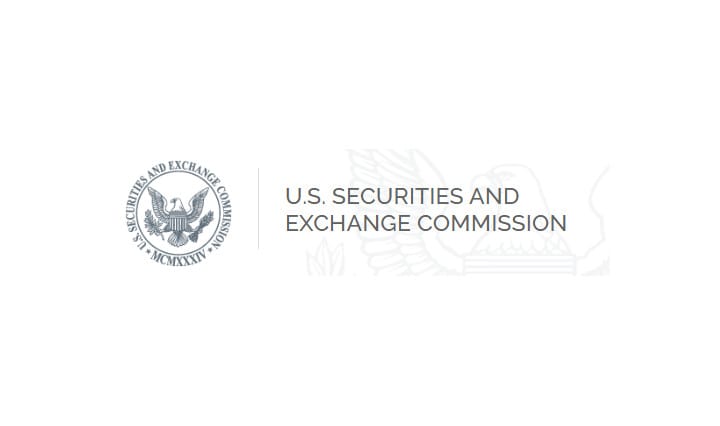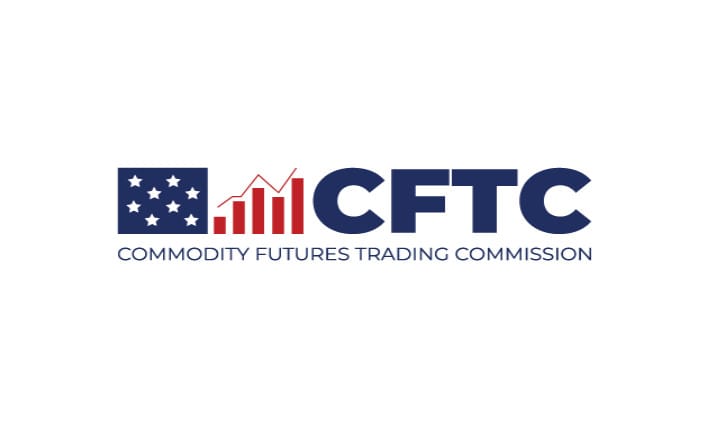Gary Gensler Statement on Final Rules Regarding Treasury Clearing: "I am pleased to support these rules because they will help to make this vital part of our capital markets more efficient, competitive, and resilient."
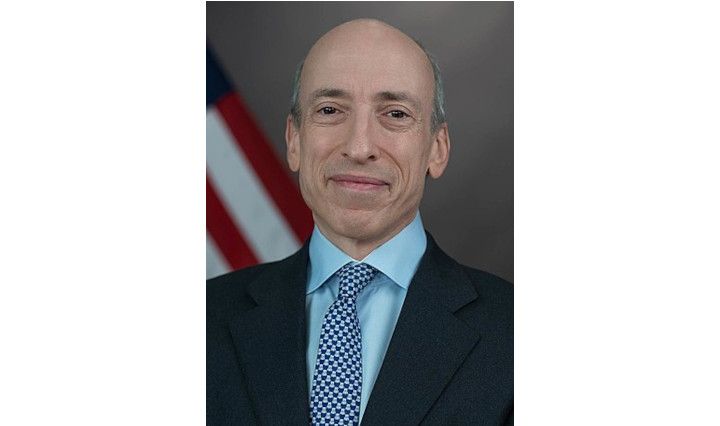
Source: https://www.sec.gov/news/statement/gensler-statement-treasury-clearing-121323
Today, the Commission is considering whether to adopt rules regarding the central clearing of U.S. Treasury securities. I am pleased to support these rules because they will help to make this vital part of our capital markets more efficient, competitive, and resilient.
The $26 trillion Treasury market—the deepest, most liquid market in the world—is the base upon which so much of our capital markets are built.[1] Treasuries are integral to how the Federal Reserve conducts monetary policy. They are how we, as a government and taxpayers, raise money. We, the public, are the issuer.
Treasuries represent a recognized safe, liquid, and reliable asset for investors around the world. The Treasury market is integral to the dollar as the dominant world currency.[2]
More than half a century ago, a 1969 Joint Treasury-Federal Reserve Study of the U.S. Government Securities Markets included a recommendation that: “Consideration should be sought in expanding clearing arrangements for U.S. Government securities.”[3]
In 1975, Congress directed the SEC to fulfill an important role overseeing clearinghouses for securities. It took until 1986, though—after a dozen nonbank Treasury dealers failed and sent shudders into the banking system—that Congress broadened the SEC’s authority to include clearinghouses in the Treasury markets.
Clearinghouses are vital to our capital markets. They facilitate what one might call the market plumbing, that which happens after you execute a transaction through the time that it settles. Standing in the middle of the securities markets, clearinghouses are the buyer to every seller and the seller to every buyer.
While central clearing does not eliminate all risk, it does lower it. First, clearinghouses do so by sitting in the middle and reducing all the risks amongst and between counterparties. They also provide multi-party netting, which helps lower the overall margin (collateral) needed to be posted in the system. Further, central clearing reduces risks through the robust rules of the clearinghouses themselves, including for the collection of initial and variation margin.
By 2022, however, only “approximately 20 percent of all repo and 30 percent of reverse repo is centrally cleared via FICC.”[4] As relates to cash transactions, by 2017, only 13 percent of Treasury cash transactions were fully centrally cleared.[5]
Further, inter-dealer brokers (IDBs), which sit in the middle of these markets, often are bringing just one side of the trades on their platforms into central clearing.[6]
Having such a significant portion of the Treasury markets uncleared—70 to 80 percent of the Treasury funding market and at least 80 percent of the cash markets—increases system-wide risk.
Another characteristic of the Treasury markets is the use of leverage of intermediaries. Such intermediaries and other market participants often fund their positions in Treasuries in the repurchase agreement (repo) markets. The resulting leverage often is facilitated by prime brokerage relationships between hedge funds and nonbank intermediaries on the one hand and banks and broker-dealers on the other.
Many hedge funds are receiving the vast majority of their repo financing in the non-centrally cleared market.[7]
In a study of non-centrally cleared bilateral repo data collected in June 2022, the Office of Financial Research (OFR) said that 74 percent of pilot volume was transacted at zero haircut.[8]
Today’s adopting release addresses clearing of Treasury securities in two important ways.
First, the final rules make changes to enhance customer clearing. Enhanced access to central clearing can facilitate all-to-all trading, competition, and resiliency in these markets.
Foremost, when posting margin to the clearinghouse, members no longer will be able to net their customers’ positions against their own proprietary positions. This will better protect customers as well as the clearinghouse itself. Further, I think it could enhance competition as broker-dealers will no longer be able to use their customer positions to lower the margin they post to the clearinghouse.
The final rules also will allow for customer margin collected by broker-dealers to be onward posted to the clearinghouse. Allowing such rehypothecation helps both protect customers and free up broker-dealers’ resources.
Market participants have experience with similar rules regarding both gross margining and rehypothecation in the swaps, options, and derivatives markets. It is fitting to apply similar rules to the Treasury markets.
The final rules also will require clearinghouses to have policies and procedures designed to ensure they facilitate access to clearing services, including for indirect participants, such as through sponsored clearing. This will help promote greater access to clearing and settlement services in the Treasury markets.
Second, the final rules broaden the scope of which transactions clearinghouse members must clear. The final rules will require clearinghouses in the Treasury markets to ensure that their members clear all their repo and reverse repo transactions. The volume of such transactions has grown significantly in the last few years. In the second half of 2022, the daily transaction volumes in the Treasury repo markets were give or take $4 trillion a day.[9]
The final rules also will mandate that clearinghouses require their members clear any cash trades executed on an IDB platform, with registered broker-dealers, or with registered government securities broker-dealers.
In finalizing these rules, we benefitted substantially from working with the Federal Reserve, the U.S. Department of the Treasury, the Federal Reserve Bank of New York, and the Commodity Futures Trading Commission. I thank the leadership and staff at these agencies for their efforts over the last two and a half years.
Further, we benefitted from robust public input on these rules. I want to highlight just two such areas. First, the final rules will narrow the scope of Treasury cash market transactions required to be cleared to those involving an interdealer broker or broker-dealer. Further, the final rules also will provide for a conditional exemption for repo transactions between a clearing member and its bank, broker-dealer, and futures commission merchant affiliates as long as the affiliates submit client repo transactions for clearing.
These rules provide for a phased implementation over two-and-a-half years. This begins with 15 months for the clearinghouses to propose and adopt rules enhancing customer clearing. Following this is nine months for clearinghouse members to comply with requirements to clear certain cash trades. In the last phase, 30 months from now, clearinghouses members will need to comply with requirements to clear certain repo and reverse repo transactions.
Today’s final rules, taken together, will reduce risk across a vital part of our capital markets in normal times and stress times. That benefits investors, issuers, and the markets connecting them.
What Gary is happy to support:
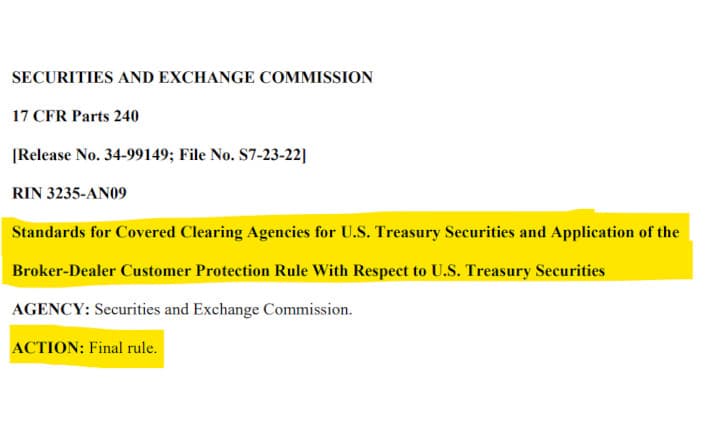
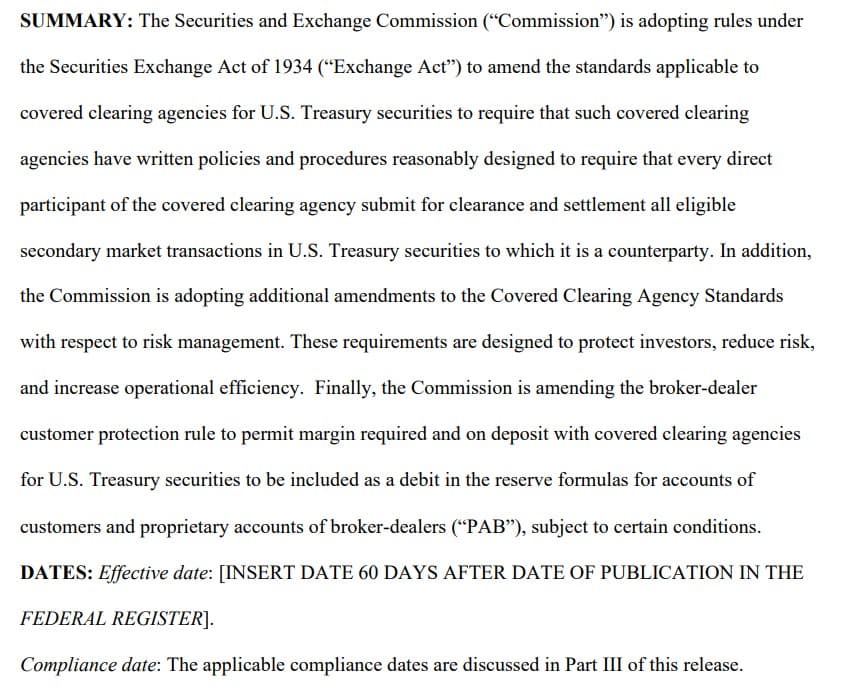
The Commission is responsible for facilitating the establishment of a national system for the prompt and accurate clearance and settlement of securities transactions. This responsibility includes the authority to regulate clearing agencies engaged in the clearance and settlement of government securities transactions, including U.S. Treasury securities. This inclusion of government securities, including U.S. Treasury securities, within the Commission’s authority for the national system of clearance and settlement underscores the importance of, among other things, the U.S. Treasury market.
U.S. Treasury securities play a critical and unique role in the U.S. and global economy, serving as a significant investment instrument and hedging vehicle for investors, a risk-free benchmark for other financial instruments, and an important mechanism for the Federal Reserve’s implementation of monetary policy. Consequently, confidence in the U.S. Treasury market, and in its ability to function efficiently, even in times of stress, is critical to the stability of the global financial system.
CCPs provide an important role for securities markets, interposing themselves between the counterparties to securities transactions, acting functionally as the buyer to every seller and the seller to every buyer. The Commission regulates CCPs as covered clearing agencies (“CCA”). The Commission historically has acknowledged the benefits that a CCP brings to the markets it serves. By novating transactions (that is, becoming the counterparty to both sides of a transaction), a CCP addresses concerns about counterparty risk by substituting its own creditworthiness and liquidity for the creditworthiness and liquidity of the counterparties. Further, the Commission has recognized that “the centralization of clearance and settlement activities at covered clearing agencies allows market participants to reduce costs, increase operational efficiency, and manage risks more effectively.” A CCP also provides a centralized system of default management that can mitigate the potential for a single market participant’s failure to destabilize other market participants or the financial system more broadly. However, the Commission has also recognized that this centralization of activity at clearing agencies makes risk management at such entities a critical function.
Because of the importance of risk management at CCPs and to further the establishment of linked and coordinated facilities for clearance and settlement of securities transactions, in 2016, the Commission adopted the Covered Clearing Agency Standards. These standards address all aspects of a CCP’s operations, including financial risk management, operational risk, default management, governance, and participation requirements. The Commission has had the opportunity to administer this new regulatory framework, considering many rule filings with respect to proposed rule changes filed by CCAs pursuant to their rule filing obligations as selfregulatory organizations (“SROs”) under Section 19(b) of the Exchange Act that address how the proposed rule changes are consistent with the Exchange Act and the Covered Clearing Agency Standards thereunder.
The Commission also has had the opportunity to observe the U.S. Treasury market, including with respect to the clearance and settlement of U.S. Treasury security transactions in both the cash and repo market. In particular, the Commission understands that the proportion of transactions that are centrally cleared has declined over the past years. One recent analysis by the Treasury Market Practice Group estimates that only 13 percent of the overall volume in U.S. dollars of U.S. Treasury cash transactions were centrally cleared as of the first half of 2017, and that an additional 19 percent were what the TMPG refers to as “hybrid” clearing, that is, executed on an interdealer broker platform (as discussed in parts II.A.1 and II.A.2.b.ii infra) in which one counterparty is a member of a CCA and submits its transaction with the interdealer broker for central clearing, while the other counterparty is not a member of a CCA and bilaterally clears its transaction with the interdealer broker. This use of both centrally cleared and not centrally cleared transactions introduces risk into the market, because bilateral clearing involves varying risk management practices that are less uniform and less transparent to the broader market and may be less efficient with regard to netting exposures and use of collateral as compared to central clearing.
Therefore, the Commission proposed amendments to Rule 17ad-22(e)(18) to help reduce contagion risk to the CCA and bring the benefits of central clearing to more transactions involving U.S. Treasury securities, thereby lowering overall systemic risk in the market. Specifically, the Commission proposed amendments that would require CCAs for the U.S. Treasury market to establish, implement, maintain and enforce written policies and procedures reasonably designed to require that their direct participants submit for clearance and settlement certain eligible secondary market transactions, both for repos and certain categories of cash transactions. In addition, the Commission proposed amendments to address certain other issues that could help facilitate increased central clearing in the U.S. These proposed changes included amending Rule 17ad22(e)(6)(i) to require that a CCA establish, implement, maintain and enforce written policies and procedures reasonably designed to calculate, collect, and hold proprietary margin separate from customer margin, amending Rule 17ad-22(e)(18) to require that CCAs establish, implement, maintain and enforce written policies and procedures reasonably designed to ensure that they have appropriate means to facilitate access to clearance and settlement services of all eligible secondary market transactions in U.S. Treasury securities, including those of indirect participants, and amending Rule 15c3-3 to permit margin required and on deposit at covered clearing agencies providing central counterparty services for U.S. Treasury securities to be included by brokerdealers as a debit in the customer and PAB reserve formulas.
Overview:
The Securities and Exchange Commission (“Commission”) is adopting rules under the Securities Exchange Act of 1934 (“Exchange Act”) to amend the standards applicable to covered clearing agencies for U.S. Treasury securities to require that such covered clearing agencies have written policies and procedures reasonably designed to require that every direct participant of the covered clearing agency submit for clearance and settlement all eligible secondary market transactions in U.S. Treasury securities to which it is a counterparty. In addition, the Commission is adopting additional amendments to the Covered Clearing Agency Standards with respect to risk management. These requirements are designed to protect investors, reduce risk, and increase operational efficiency. Finally, the Commission is amending the broker-dealer customer protection rule to permit margin required and on deposit with covered clearing agencies for U.S. Treasury securities to be included as a debit in the reserve formulas for accounts of customers and proprietary accounts of broker-dealers (“PAB”), subject to certain conditions.
Fact Sheet:
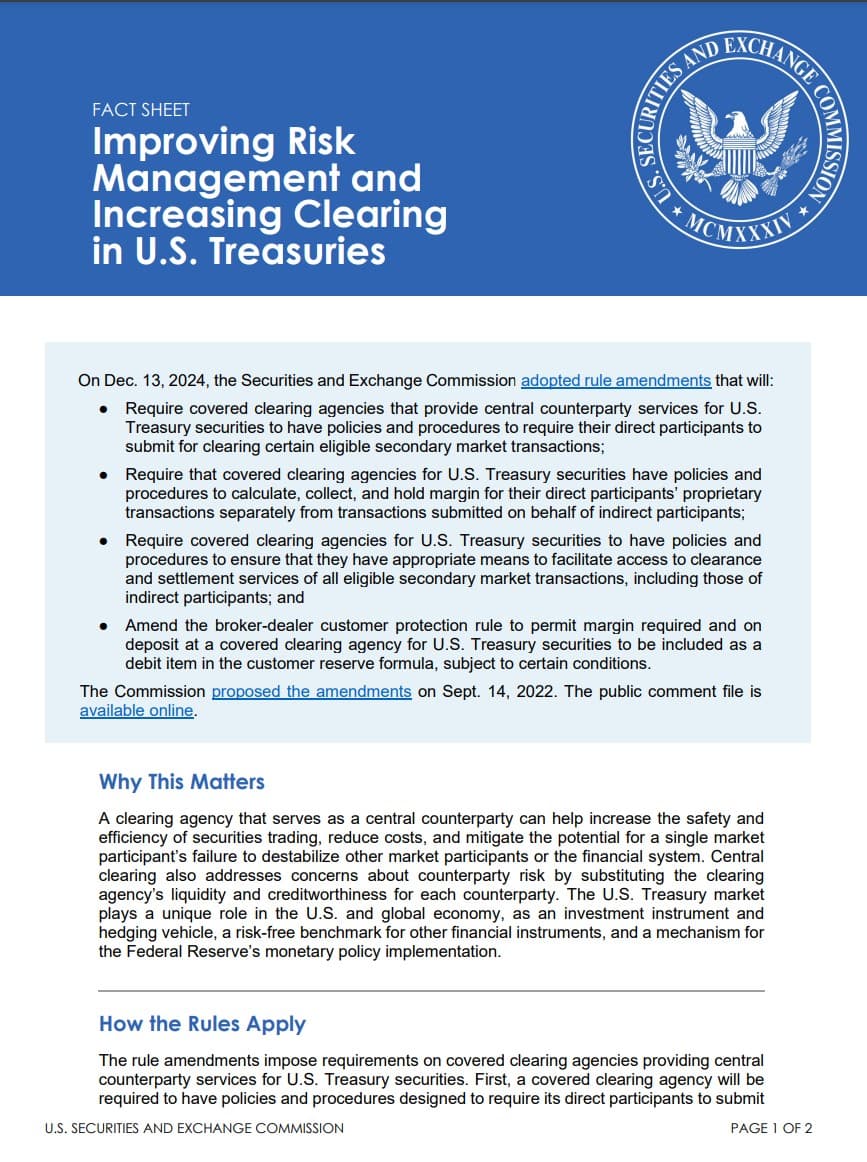
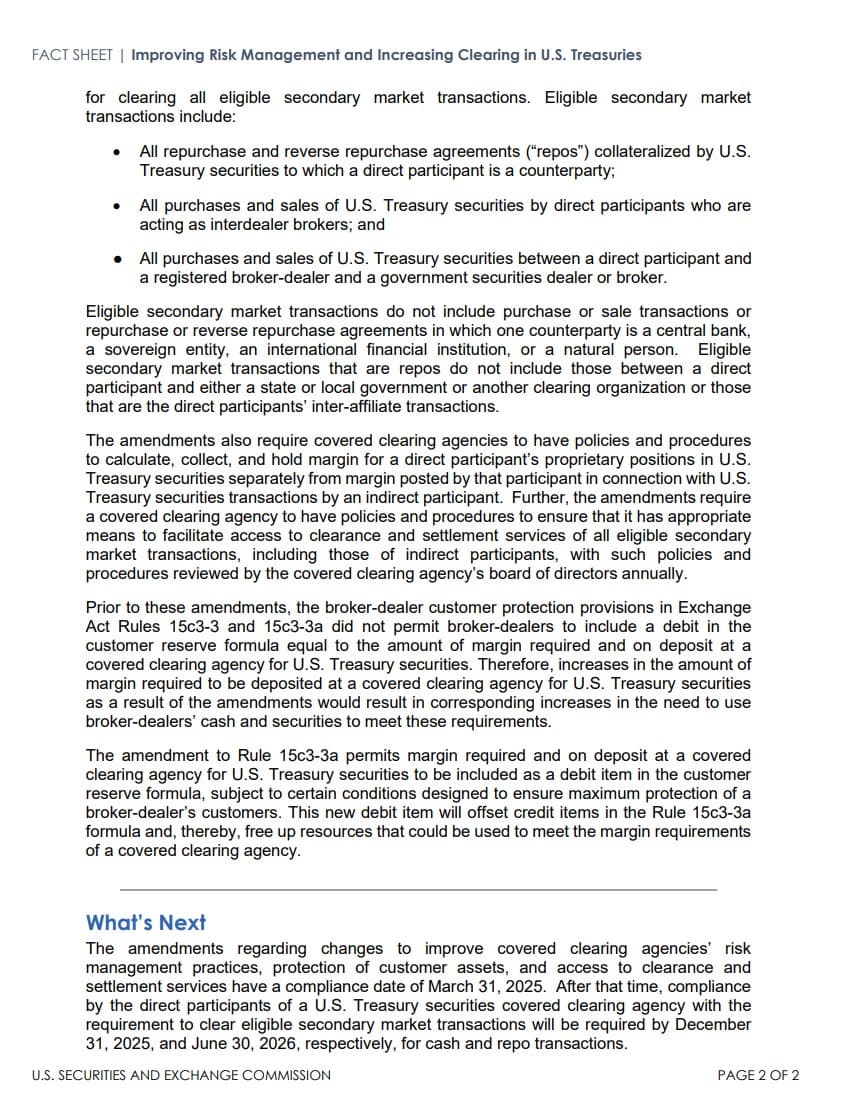
Press Release:
The Securities and Exchange Commission today adopted rule changes to enhance risk management practices for central counterparties in the U.S. Treasury market and facilitate additional clearing of U.S. Treasury securities transactions. The rule changes update the membership standards required of covered clearing agencies for the U.S. Treasury market with respect to a member’s clearance and settlement of specified secondary market transactions. Additional rule changes are designed to reduce the risks faced by a clearing agency and incentivize and facilitate additional central clearing in the U.S. Treasury market.
“The $26 trillion Treasury market — the deepest, most liquid market in the world — is the base upon which so much of our capital markets are built,” said SEC Chair Gary Gensler. “Having such a significant portion of the Treasury markets uncleared — 70 to 80 percent of the Treasury funding market and at least 80 percent of the cash markets — increases system-wide risk. Today’s adopting release addresses clearing of Treasury securities in two important ways. First, the final rules make changes to enhance customer clearing. Second, the final rules broaden the scope of which transactions clearinghouse members must clear. I am pleased to support these rules because they will help to make the Treasury market more efficient, competitive, and resilient.”
Specifically, the amendments require that covered clearing agencies in the U.S. Treasury market adopt policies and procedures designed to require their members to submit for clearing certain specified secondary market transactions. These transactions include: all repurchase and reverse repurchase agreements collateralized by U.S. Treasury securities entered into by a member of the covered clearing agency, unless the counterparty is a state or local government or another clearing organization or the repurchase agreement is an inter-affiliate transaction; all purchase and sale transactions entered into by a member of the clearing agency that is an interdealer broker; and all purchase and sale transactions entered into between a clearing agency member and either a registered broker dealer, a government securities broker, a government securities dealer.
Further, the amendments permit broker-dealers to include customer margin required and on deposit at a clearing agency in the U.S. Treasury market as a debit in the customer reserve formula, subject to certain conditions. In addition, the amendments require covered clearing agencies in this market to collect and calculate margin for house and customer transactions separately. Finally, the amendments require policies and procedures designed to ensure that the covered clearing agency has appropriate means to facilitate access to clearing, including for indirect participants. The amendments also include an exemption for transactions in which the counterparty is a central bank, sovereign entity, international financial institution, or natural person.
The amendments will go into effect in two phases, with the changes regarding the separation of house and customer margin, the broker-dealer customer protection rule, and access to central clearing required to be completed first, by March 31, 2025. After that time, the requirement to clear specific transactions would go into effect in two phases, with cash transactions being required to be cleared before repurchase transactions are required to be cleared. Compliance by the direct participants of a U.S. Treasury securities central clearing agencies with the requirement to clear eligible secondary market transactions would not be required until December 31, 2025, and June 30, 2026, respectively, for cash and repurchase transactions.

TLDRS:
- The Securities and Exchange Commission (SEC) has adopted rules to amend standards applicable to covered clearing agencies for U.S. Treasury securities, effective from December 13, 2024.
- Gary Gensler Statement on Final Rules Regarding Treasury Clearing: "I am pleased to support these rules because they will help to make this vital part of our capital markets more efficient, competitive, and resilient."
- "Many hedge funds are receiving the vast majority of their repo financing in the non-centrally cleared market."
- "In a study of non-centrally cleared bilateral repo data collected in June 2022, the Office of Financial Research (OFR) said that 74 percent of pilot volume was transacted at zero haircut."
- The compliance dates for these amendments are March 31, 2025, for risk management practices, customer asset protection, and clearance and settlement services access, and December 31, 2025, and June 30, 2026, for cash and repo transactions respectively.
- The amendments also address broker-dealer customer protection by allowing the inclusion of margin required and on deposit for U.S. Treasury securities as a debit item in the customer reserve formula, subject to conditions.
- These changes aim to increase the safety and efficiency of securities trading, reduce costs, and mitigate the potential destabilization of the financial system by a single market participant's failure.
- The rules also stipulate that covered clearing agencies must separate the calculation, collection, and holding of margin for direct participants' proprietary transactions from those of indirect participants.
- The amendments require covered clearing agencies to have policies ensuring their direct participants submit eligible secondary market transactions in U.S. Treasury securities for clearing.

